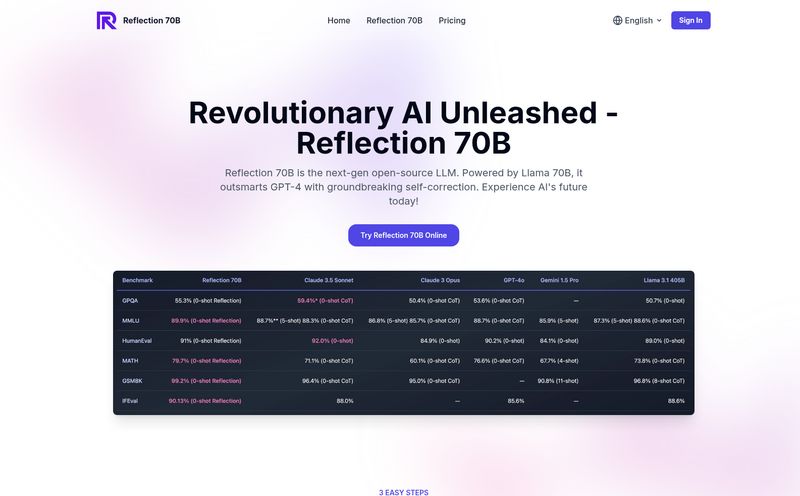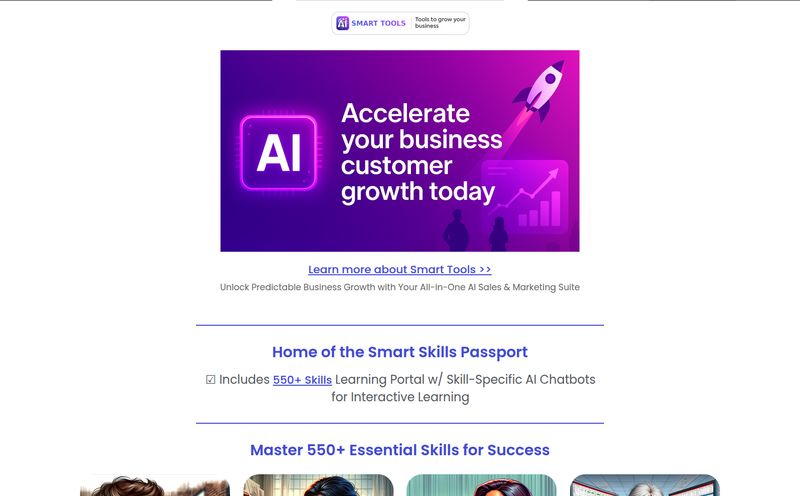We’ve all been there. You're in the shower, stuck in traffic, or trying to fall asleep, and then BAM! It hits you. An app idea so brilliant, so simple, so obviously needed that you can't believe no one’s built it yet. You get a little jolt of excitement, you start picturing the logo, maybe you even buy the domain name (I have a folder full of them, don't judge).
And then reality sets in. You can’t code. You don’t have a spare $50,000 lying around to hire a development agency. And the thought of finding a technical co-founder feels like trying to find a unicorn in a haystack. The dream slowly fades, filed away in the “someday, maybe” cabinet of your brain.
I’ve been in the online space for years, and this story is a classic. It’s the number one killer of great ideas. But the landscape is shifting, and tools are popping up that aim to bulldoze that barrier. One that recently caught my eye is ZAPT. It claims to be a no-code AI app builder for folks just like us. So, I did a little digging. Is it for real, or just another overhyped platform?
So, What's the Big Deal with ZAPT Anyway?
At its core, ZAPT is a platform designed to solve what they call the “Builder Disconnect.” It’s a great term for a problem I’ve seen firsthand. Techies build what they think people need, often over-engineering it into a confusing mess. Meanwhile, the person with the actual, practical problem is left on the sidelines.
ZAPT's whole reason for being is to bridge that gap. It’s a no-code environment, which means you build your app by dragging, dropping, and configuring elements, not by writing endless lines of Python or JavaScript. Think of it less like building a car from raw steel and more like assembling a high-performance LEGO kit. The pieces are all there; you just need to put them together with your vision.

Visit ZAPT
They specifically focus on letting non-technical entrepreneurs (or anyone with an idea, really) build and launch AI-powered applications. And they do it quickly and, on the surface, very affordably. The promise is to get your idea out of your head and into the world, generating revenue, without needing a computer science degree or a rich uncle.
The ZAPT Approach: Your Idea, Your Way (Mostly)
Okay, so how does it actually work? It's not just a single tool. They offer a few different paths, which I think is pretty smart. It’s not a one-size-fits-all solution.
The "Build It Yourself" Playground
This is the classic no-code, self-service model. You get access to their AI-powered platform and start building. The “AI assistance” part is interesting—it’s like having a helpful junior dev looking over your shoulder, suggesting things and automating some of the tedious parts. For anyone who likes to get their hands dirty and have full creative control, this is the path. You’re the architect and the construction manager. This route works on a pay-as-you-go credit system, plus a 30% revenue share once your app starts making money.
The "We Build It For You" Partnership
Now this is the one that made me lean in. A few years back, I had an idea for a simple tool to track local SEO ranking fluctuations. I got quotes from a few freelance developers. The lowest was $8,000. For ZAPT's full-service option, you tell them your idea, and their team builds it for you. The upfront cost? $500.
Yes, you read that right. Five hundred dollars. Of course, there's a catch, and it's a big one: they take a 50% share of the revenue your app generates. It’s a partnership in the truest sense. They're betting on your idea being successful just as much as you are. It’s a massive trade-off, but for a bootstrapped founder, it could be the only viable way to start.
Zaptopia, The Idea Incubator
This third option is more of a community feature. It's a place where you can submit your app ideas, and the community votes on them. ZAPT then builds the most popular ideas first. It’s like a public testing ground for market demand. If you're not even sure your idea is worth pursuing, throwing it into Zaptopia could be a zero-risk way to find out.
Let's Talk Turkey: The ZAPT Pricing Model
Let's lay it out clearly because this is where you'll make your decision. The money part is always the most important part, isn't it.
| Service Model | Upfront Cost | Revenue Share | Who Is It For? |
|---|---|---|---|
| Self-Service | Pay-as-you-go credits | 30% to ZAPT | The DIYer who wants control |
| Full-Service | $500 flat fee | 50% to ZAPT | The visionary with no time/skill to build |
The revenue share is going to be the sticking point for many. Giving away 30% or 50% of your revenue forever sounds… painful. And it is. But here's my take: is 50% of something better than 100% of nothing? For many, the answer is a resounding yes. This model completely flips the traditional risk profile. Instead of the founder taking all the financial risk upfront, ZAPT shares a huge chunk of it.
The Good, The Bad, and The Code-Free
No platform is perfect. Ever. As an SEO, I live in a world of trade-offs, and ZAPT is no different. It's a powerful tool, but it comes with its own set of compromises.
What I Really Like About ZAPT
The low upfront cost is obviously a huge plus. It democratizes app development. But what's more exciting to me is their use of Progressive Web App (PWA) technology. This means your app runs in a web browser but can be 'installed' on a user's home screen, send push notifications, and even work offline. You get the feel of a native app without the nightmare of App Store approvals, fees and updates. From a traffic generation perspective, this is gold. Your app is indexable by Google, and you can drive traffic to it just like any other website.
The speed is the other major benefit. You can go from idea to a minimum viable product (MVP) in a fraction of the time of traditional development. This lets you test your idea in the real market before you sink your life savings into it.
Some Things to Keep in Mind
Okay, let's be real. The revenue share is a long-term cost you have to be comfortable with. If your app becomes a runaway success earning millions, that 50% is going to sting. You’re also building on their turf. This means you’re reliant on ZAPT's platform, their technology, and their continued existence. You can’t just pick up your code and move to another server. That platform lock-in is a serious consideration for any long-term project.
And while no-code is powerful, it has its limits. If your app idea requires some truly bizarre, ground-breaking functionality, a no-code builder might not be flexible enough. Finally, that amazing $500 build-it-for-me deal? I'm sure there's a selection process. They're not going to build just any idea; they'll pick the ones they believe have the best chance of succeeding. It's not a guaranteed ticket.
Is ZAPT the Right Tool for Your Big Idea?
So who is this really for? In my opinion, ZAPT is a fantastic option for a few key groups:
- Non-Technical Founders: This is the dead-center of their target audience. If you have a business problem you want to solve with an app but your coding ability stops at editing a Wordpress theme, ZAPT is for you.
- Bootstrappers & Solopreneurs: If you're self-funding your dream on a shoestring budget, the low upfront cost is a lifesaver.
- MVP Testers: If you just want to build a functional version of your app to prove the concept and get user feedback, this is an incredibly fast and cheap way to do it.
It's probably not the best fit for a VC-backed startup that needs to own 100% of its IP from day one, or for someone building an app with extremely complex, novel technical requirements.
Final Thoughts
ZAPT isn't a magic wand that will instantly create a million-dollar app. But it is a very, very powerful tool that dramatically lowers the barrier to entry. It's a classic trade-off: you sacrifice a percentage of potential future earnings and some technical freedom in exchange for low risk, incredible speed, and accessibility.
For the thousands of people with brilliant ideas locked in their heads, that's a trade worth considering. It’s a chance to finally see if your idea has legs, without betting the farm. And in the world of entrepreneurship, that’s a pretty exciting proposition.
Frequently Asked Questions about ZAPT
- Do I need to know how to code to use ZAPT?
- Absolutely not. That's the entire point. The platform is designed for non-technical users, especially with the "We Build It For You" option.
- What is a Progressive Web App (PWA)?
- A PWA is a web-based application that can be accessed via a URL but offers an app-like experience. Users can add it to their home screen and get push notifications, all without going through an app store. It's a hybrid that combines the best of websites and mobile apps.
- How does ZAPT make money with the $500 build option?
- They make their money on the back end. The $500 fee likely just covers their initial labor costs. Their real profit comes from the 50% revenue share they take from successful apps. They are betting on your success.
- Can I build any kind of app on ZAPT?
- While it's versatile, no-code platforms generally have limitations. It's excellent for building many types of business tools, AI-powered services, and data-driven apps. However, for something like a high-performance 3D game or an app requiring deep hardware integration, you'd likely still need custom development.
- What happens to my app if I want to leave ZAPT?
- This is a critical question. Since your app is built on their proprietary platform, you can't simply download the code and host it elsewhere. Leaving ZAPT would likely mean losing the app you've built. This platform lock-in is a major trade-off for the convenience and low cost.



